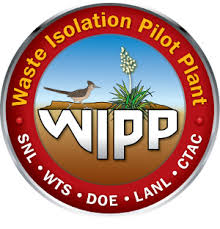The Waste Isolation Pilot Plant (WIPP) is the third deep geological repository for nuclear waste in the world. The first two were located in Germany and are closed. The WIPP is licensed to permanently dispose of transuranic radioactive waste left over from the development and manufacture of nuclear weapons. It is supposed to safely isolate nuclear waste for ten thousand years. It is located twenty-six miles from Carlsbad, New Mexico.
I have blogged about the WIPP before when barrels of radioactive waste from the Los Alamos National Laboratory exploded in the repository and radioactive materials were released into the atmosphere. It turned out that the barrels were improperly prepared and improperly stored in the repository. The repository had to be shut down for three years while it was repaired at a cost of millions of dollars.
Now the U.S. Department of Energy has put fourth a proposal for the reclassification of some high-level radioactive wastes that would expand the types of waste that can be stored at the WIPP. Waste resulting from the processing of nuclear fuel could be classified as transuranic and sent to WIPP. There is currently no geological repository for such nuclear waste in the U.S. and the volume of such waste is steadily increasing.
Currently, whether or not drums of radioactive waste can be stored at WIPP depends more on the origin of the drums than on their contents. There are one hundred and seventy-seven tanks holding fifty-six million gallons of liquid nuclear waste being stored at the Hanford Nuclear Reservation left over from the reprocessing of spent nuclear fuel. The cost of storing this waste at Hanford is billions of dollars a year. The way that it is currently classified prevents it from being eligible for storage at WIPP.
John Heaton, chair of the Carlsbad Mayor’s Nuclear Task Force, says that, “A lot of (the waste at Hanford) would pass the waste acceptance criteria at WIPP. It would extend the life of WIPP for sure. They’re spending billions of dollars on this stuff a year. The only risk reduction that’s happening is in what’s coming to WIPP.” However, if the waste at Hanford is reclassified, it could also be stored at ground-level repositories. Heaton admits that, “If more of it could be disposed of near the surface, it could negatively impact WIPP. It is whatever method is cheapest. A lot of it will be low-level, but there will definitely be some TRU waste that’s destined for WIPP.”
The Energy Communities Alliance (ECA) is a nonprofit organization of communities and local governments impacted by the activities of the DoE. A 2017 report from the ECA said, “For too long, costly treatment and disposal decisions have been made base on artificial standards, ones that base waste classification on the origin rather than the actual characteristics and risk to human health arising from the waste. The change could result in about $40 billion in savings to tax payers. We also understand that some have an interest in not evolving and leaving the waste in place. The local communities find this unacceptable.”
Don Hancock is the director of the Nuclear Waste Program at the Southwest Research and Information Center. He says that the DoE proposal is not only illegal but also hypocritical. He points out that high level waste is defined repeatedly in different laws passed by Congress and that the DoE proposal would seek to circumvent congressional powers. He also said that if the waste in question is really less dangerous that was previously thought, then there is no reason that it cannot be safely kept where it is. Hancock says, “What it seems like they’re proposing is illegal. They say they get to rewrite the law, not Congress. They’re a lot of opposition to this nationally.”
Hancock explains that the DoE proposal was also intended to circumvent the federal law that requires high-level nuclear waste to be stored underground by changing the classification. He says, “There was a consensus that there should be multiple geologic repositories. There should be multiple places in the U.S. where you can have safe repositories. That didn’t happen.”
